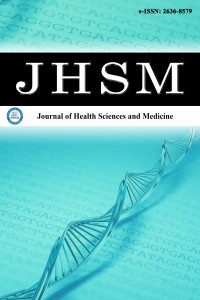1.
OECD. Health at a glance: OECD indicators-2005 edition, multilingual summaries https://web-archive.oecd.org/2012-06-15/147667-35636867.pdf (access date: 7.4.2024).
2.
Grossman, M. The human capital model of the demand for health. Working Paper 7078, National Bureau of Economic Research, New York; 1999.
3.
Sofuoğlu, A. Hava kirliliği. İzmir Yüksek Teknoloji Enstitüsü, İzmir, 2003.
4.
Menteşe, S. Çevresel sürdürülebilirlik açısından toprak, su ve hava kirliliği: teorik bir inceleme. J Int Soc Res. 2017;10(53):381-389. doi:10. 17719/jisr.20175334127
5.
Worldbank. https://data.worldbank.org (access date: 10.10.2024).
6.
Jaunky VC. The CO<sub>2</sub> emissions-income nexus: evidence from rich countries. Energy Policy. 2011;39(3):1228-1240. doi:10.1016/j.enpol.2010. 11.050
7.
Arouri MEH, Youssef AB, Mhenni H, Rault C. Energy consumption, economic growth and CO<sub>2</sub> emissions in Middle East and North African countries. Energy Policy. 2012;45(C):342-349. doi:10.1016/j.enpol.2012. 02.042
8.
Apergis N, Jebli MB, Youssef SB. Does renewable energy consumption and health expenditures decrease carbon dioxide emissions? Evidence for sub-Saharan Africa countries. Renewable Energy. 2018;127(C):1011-1016. doi:10.1016/j.renene.2018.05.043
9.
Ozcan B. The nexus between carbon emissions, energy consumption and economic growth in Middle East countries: a panel data analysis. Energy Policy. 2013;62:1138-1147. doi:10.1016/j.enpol.2013.07.016
10.
Nasreen S. Association between health expenditures, economic growth and environmental pollution: long-run and causality analysis from Asian economies. Int J Health Plann Manage. 2021;36(3):925-944. doi: 10.1002/hpm.3132
11.
Haseeb M, Kot S, Hussain HI, Jermsittiparsert K. Impact of economic growth, environmental pollution, and energy consumption on health expenditure and R&D expenditure of ASEAN countries. Energies. 2019; 12(19):1-21. doi:10.3390/en12193598
12.
Yahaya A, Nor NM, Habibullah MS, Ghani JA, Noor ZM. How relevant is environmental quality to per capita health expenditures? Empirical evidence from panel of developing countries. Springerplus. 2016;5(1): 925. doi:10.1186/s40064-016-2505-x
13.
Dogan, E., and Aslan, A. (2017). Exploring the relationship among CO<sub>2</sub> emissions, real GDP, energy consumption and tourism in the EU and candidate countries: evidence from panel models robust to heterogeneity and cross-sectional dependence. Renewab Sustainab Energy Rev. 2017;77:239-245. doi:10.1016/j.rser.2017.03.111
14.
Wang CM, Hsueh HP, Li F, Wu CF. Bootstrap ARDL on health expenditure, CO<sub>2</sub> emissions, and GDP growth relationship for 18 OECD countries. Front Public Health. 2019;7:324. doi:10.3389/fpubh.2019. 00324
15.
Hossain S. Panel estimation for CO<sub>2</sub> emissions, energy consumption, economic growth, trade openness and urbanization of newly industrialized countries. Energy Policy. 2011;39(11):6991-6999. doi:10. 1016/j.enpol.2011.07.042
16.
Anastacio JAR. Economic growth, CO<sub>2</sub> emissions and electric consumption: is there an environmental Kuznets curve? An empirical study for North America countries. Int J Energy Econom Policy. 2017; 7(2):65-71.
17.
Gövdeli T. Health Expenditure, economis growth, and CO<sub>2</sub> emissions: evidence from the OECD countries. Adiyaman Uni J Soc Sci. 2019;11(31); 488-516. doi:10.14520/adyusbd.477571
18.
Bekun FV, Alola AA, Gyamfi BA, Yaw SS. The relevance of EKC hypothesis in energy intensity real-output trade-off for sustainable environment in EU-27. Environ Sci Pollut Res Int. 2021;28(37):51137-51148. doi:10.1007/s11356-021-14251-4
19.
Zaidi S, Saidi K. Environmental pollution, health expenditure and economic growth in the sub-Saharan Africa countries: panel ARDL approach. Sustainab Cities Soc. 2018;41:833-840. doi:10.1016/j.scs.2018. 04.034
20.
Akbar M, Hussain A, Akbar A, Ullah I. The dynamic association between healthcare spending, CO<sub>2</sub> emissions, and Human Development Index in OECD countries: evidence from panel VAR model. Environ Develop Sustainabil. 2021;23(7):10470-10489. doi:10.1007/s10668-020-01066-5
21.
Keyifli N, Recepoğlu M. Sağlık harcamaları, CO<sub>2</sub> emisyonu, yenilenebilir enerji tüketimi ve ekonomik büyüme: bootstrap panel nedensellik testinden kanıtlar. Karadeniz Teknik Üni Sos Bil Enstit Sos Bil Derg. 2020;10(20):285-305.
22.
Mujtaba G, Shahzad SJH. Air pollutants, economic growth and public health: implications for sustainable development in OECD countries. Environ Sci Pollut Res Int. 2021;28(10):12686-12698. doi:10.1007/s11356-020-11212-1
23.
Elmi ZM, Sadeghi S. Health care expenditures and economic growth in developing countries: panel co-integration and causality, Middle-East. J Sci Res. 2012;12(1):88-91. doi:10.5829/idosi.mejsr.2012.12.1.64196
24.
Şen H, Kaya A, Alpaslan B. Education, health, and economic growth nexus: a bootstrap panel granger causality analysis for developing countries. Socioeconomics. 2018;26(36):125-144. doi:10.17233/sosyoekonomi. 2018.02.07
25.
Omri A. CO<sub>2</sub> emissions, energy consumption and economic growth nexus in MENA countries: evidence from simultaneous equations models. Energy Econom. 2013;40:657-664. doi:10.1016/j.eneco.2013.09. 003
26.
Li K, Lin B. Impacts of urbanization and industrialization on energy consumption/CO<sub>2</sub> emissions: does the level of development matter? Renewab Sustainab Energy Rev. 2015;52:1107-1122. doi:10.1016/j.rser.2015. 07.185
27.
Yazdi SK, Khanalizadeh B. Air pollution, economic growth and health care expenditure. Econom Res. 2017;30(1):1181-1190. doi:10.1080/1331677X.2017.1314823
28.
Samadi A, Homaie Rad E. Determinants of healthcare expenditure in economic cooperation organization (ECO) countries: evidence from panel cointegration tests. Int J Health Policy Manag. 2013;1(1):63-68. doi:10.15171/ijhpm.2013.10
29.
Breusch TS, Pagan AR. The lagrange multiplier test and its applications to model specification in econometrics. Rev Econom Stud. 1980;47(1):239-253. doi:10.2307/2297111
30.
Hsiao C. Analysis of panel data. Econometric society monographs, vol 11. Cambridge University Press, New York. 1986.
31.
Westerlund, J. Panel cointegration tests of the fisher effect. J Appl Econometr. 2008;23(2):193-233. doi:10.1002/jae.967
32.
Pesaran MH. A simple panel unit root test in the presence of cross-section dependence. J Appl Econometr. 2007;22(2):265-312. doi:10.1002/jae.951
33.
Pesaran MH, Shin Y, Smith RJ. Bound testing approaches to the analysis of long-run relationships. J Appl Econometr. 2001;16(3):289-326. doi:10. 1002/jae.616
34.
Westerlund J, Edgerton DL. A panel bootstrap cointegration test. Econom Lett. 2007;97(3):185-190. doi:10.1016/j.econlet.2007.03.003
35.
Öztürk E. Elektrik tüketimi ile ekonomik büyüme arasındaki nedensellik ilişkisi: üst orta gelir grubu ülkeler panel veri analizi. Uluslararası İşlet Ekonom Yönet Perspekt Derg. 2018;1:1-10. doi:10.29228/ijbemp.6695
36.
Aktaş N. E7 ülkelerindeki Ar-Ge harcamalarının yüksek teknolojili ürün ihracatlarına etkisi. Bil Teknol Yenilik Ekosist Derg. 2022;3(1):1-9.
37.
Eberhard JP. Applying neuroscience to architecture. Neuron. 2009;62(6): 753-756. doi:10.1016/j.neuron.2009.06.001

